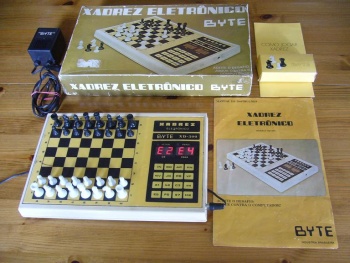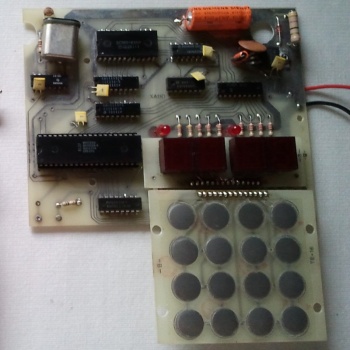Splice Byte XD-300: Unterschied zwischen den Versionen
Keine Bearbeitungszusammenfassung |
Keine Bearbeitungszusammenfassung |
||
| Zeile 7: | Zeile 7: | ||
C Picture by [http://www.chesscomputeruk.com/ Michael Watters - Chess Computer UK] | C Picture by [http://www.chesscomputeruk.com/ Michael Watters - Chess Computer UK] | ||
| Hersteller = [[Splice]] | | Hersteller = [[Splice]] | ||
| Markteinführung = {{Erscheinungsjahr| | | Markteinführung = {{Erscheinungsjahr|1980}} (?) | ||
| Preis = | | Preis = | ||
| Prozessor = [[Z80]] | | Prozessor = [[Z80]] | ||
Version vom 8. Januar 2024, 21:32 Uhr
| Splice Byte XD-300 | |||
|---|---|---|---|
 C Picture by Michael Watters - Chess Computer UK |
|||
| Hersteller | Splice | ||
| Markteinführung | 1980 (?) | ||
| CElo | 1311 | ||
| Programmierer | Nelson, Ron | ||
| Prozessor | Takt | RAM | ROM |
| Z80 | ~3,6 MHz (3,582 MHz) | 256 Bytes | 4 KB |
| Rechentiefe | BT-2450 | BT-2630 | Colditz |
| Bibliothek | 69 Positionen | ||
| Display | 4-stellige 7-Segment LED Anzeige | ||
| Spielstufen | 7 | ||
| Zugeingabe | Tastatur | ||
| Zugausgabe | Display | ||
| Einführungspreis | |||
| Prozessortyp | 8 Bit | ||
| Stromversorgung | Netzteil: 9V/350mA DC (Cinch-Stecker, Plus innen) | ||
| Maße | |||
| Verwandt | Fidelity Chess Challenger 7 | ||
| Sonstiges | |||
| Clone of the Fidelity Chess Challenger 7 | |||
| Infos |
|---|
| An analysis of the XD-300 revealed what it seems to be a clone of the Fidelity Chess Challenger 7. There are some minor differences, for example, the pads between the keypad and the sensors underneath the board are very different giving a different feeling when you press the keys. Not better or worse, just different. Also, it uses a true speaker instead of a piezo beeper as in the Fidelity Chess Challenger 7. But the hardware architecture is the same (CPU type and signal clock, RAM, etc.), and the content of the ROM is identical. |
Comparison with Fidelity Chess Challenger 7
 |
 |
 |
 |
 |
C Pictures by Michael Watters - Chess Computer UK
 |
